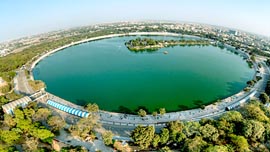Ahmedabad
Ahmedabad, the city of Ahmed Shah (Medieval ruler of Gujarat), is known for its rich past and its association with the Mahatma (Great Soul), also known as Mohandas Karamchand Gandhi. The city offers the traveler a unique style of architecture, which is a blend of Hindu and Islamic styles (Indo-Saracenic style of architecture). The monuments of Ahmedabad mainly date back to the 15th century. Ahmedabad has been known for its industry since medieval times. Presently it is famous for its textile mills and is often referred to as the 'Manchester of the East'.
TOURIST DESTINATIONS OF AHMEDABAD
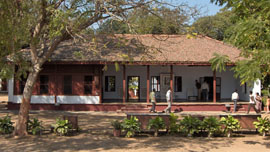
Gandhi Ashram
True, indeed, that wherever Gandhi stopped has become a place of pilgrimage and wherever he roamed has become a sanctified place. The Sabarmati Ashram in Ahmedabad, so named after the holy river Sabarmati, situated on the river's banks is such an example. This site no longer functions as a working ashram but as a museum and an institution whose aim is to preserve and propagate the legacy of the Mahatma. Hundreds of visitors, both foreigners and locals, with curiosity and feelings of devotion arrive here and feel inspired and enlightened. More than half a million visit here every year. The Sabarmati Ashram is a source of inspiration for the present generation, and will serve as such for the generations to come. Indeed, Gandhi's ideals will serve as a beacon light for all generations. The Ashram has stood witness to many important happenings, happenings which were instrumental in shaping the Karmavir Mohandas into the Mahatma and the Father of the Nation.
Jama Masjid
Located in the centre of the old city, this congregational mosque was built by Sultan Ahmed Shah in 1423. Built in yellow sandstone, it combines the best of Hindu and Muslim styles of architecture, standing on 260 pillars supporting 15 domes at varying elevations It is described as the most beautiful mosque in India. The vast paved courtyard is a rectangle nearly seventy-five metres by sixty-six metres.
The splendid mosque built by Muhammad Ali Shah in the typical Mughal style with two minarets and three domes, lies to the west of the Hussainabad Imambara and is entirely free from pseudo Italian art then in vogue in Lucknow. Mohammad Ali Shah started the construction of this splendid mosque in 1840 but his wife Begum Malika Jahan finally completed it after his death. It is the country's largest mosque, built in 1656, where thousands of Muslims offer prayers. It lies opposite the Red Fort and is surrounded by a large number of shops, which deal in a variety of goods.
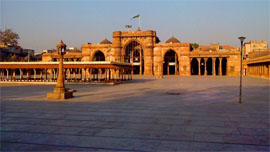
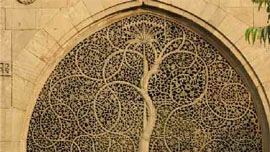
Sidi Sayed Jhali
This elegant mosque is noted for its twin windows of pierced stone, worked in style of a tree with palm leaves and curving tendrils. A superb and peerless example of delicate carving that transforms stone into filigree. It was constructed by Sidi Saiyad, a slave of Ahmed Shah, and has beautiful carved stone windows depicting the intricate intertwining of the branches of a tree. Wooden models of these windows, a fine example of Indo-Sarcenic architecture are kept in the New York and Kensington museums.
Akshardham
It is believed that there are three forms of visual art : Painting is art to look at, sculpture is art you can walk around, and architecture is art you can walk through While you walk down the streets of Ahmedabad, this is one place where you will experience the treasure trove of Gujarati architecture.
A unique edifice celebrating the teachings of Swaminarayan faith is an amazing example of great craftsmanship and sandstone carvings. The famous Akshardham temple temple, located at Gandhi Nagar, is visited by over 2 million visitors annually. This architecturally diaphanous masterpiece is a symbol of humanity and has glorified the Indian Culture. The temple houses idol of Hindu Lord Swaminarayan, the founder of Swaminarayan Faith.
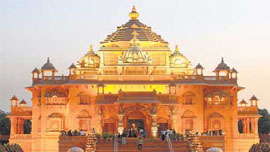

Rajkot
This bustling town was once the capital of the princely state of Saurashtra and is also a former British government headquarters. Mahatma Gandhi spent the early years of his life here. The Gandhi family home, the Kaba Gandhi no Delo, now houses a permanent exhibition of Gandhi items. The prestigious Rajkumar College dates back to the second half of last century and is regarded as one of the best private schools in the country. It was one of five schools set up by the British for the education of the sons of nobility (rajkumar means prince).
Kankaria Lake
Kankaria Lake is another tourist attraction of Ahmedabad. The Kankaria Lake is a circular lake constructed in AD 1451 by Sultan Qutub-ud-din. Amongst the places to be visited in the lake is the island garden at its centre with a summer palace known as Nagina Wadi. Lush green parks, an aquarium, a boat club, a natural historical museum, and a zoo surrounding the park make the lake a place to be seen in Ahmedabad. The 'Bal Vatika' or the children's park makes it a great picnic spot and attracts tourists and localities from Ahmedabad alike.
